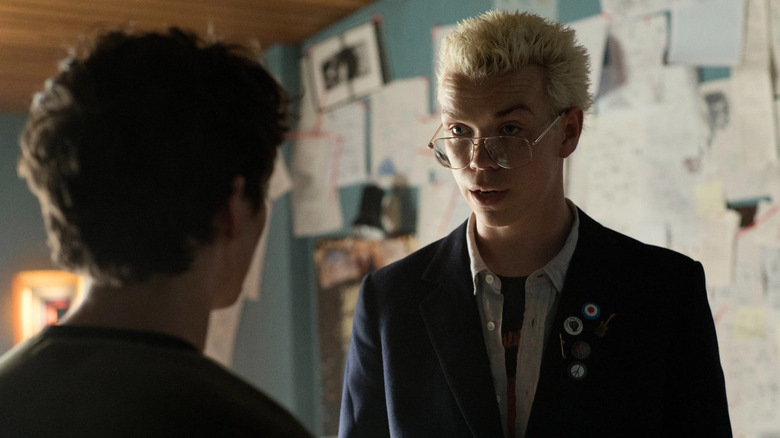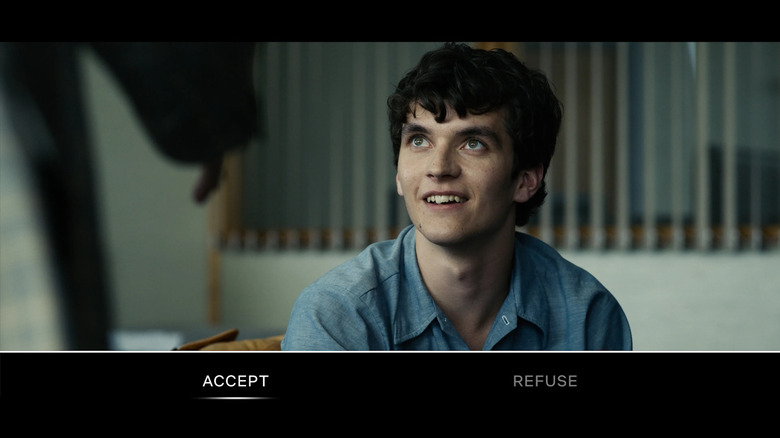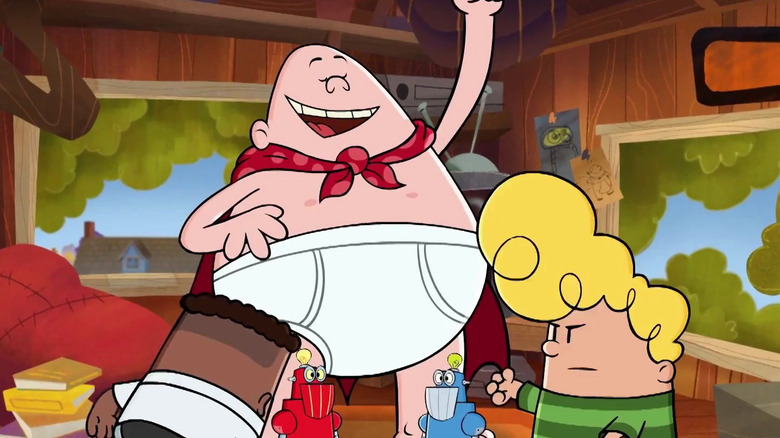Netflix Is Removing Black Mirror's Boldest And Most Experimental Episode
Back in 2018, writer Charlie Brooker and director David Slade created a "Black Mirror" spinoff movie called "Bandersnatch," which was to be a bold media experiment. The plot of "Bandersnatch" followed a young computer programmer named Stefan (Fionn Whitehead) on his quest to adapt one of his favorite Choose-Your-Own-Adventure novels (also called "Bandersnatch") into an open-ended video game. It's 1984, and such games are still considered a novelty. He teams up with Colin (Will Poulter), a game designer, and the two begin butting heads over creative control and how corporate the game should be. There are subplots about Stefan's dead mother, and clues to the world ahead based on what he says in therapy.
The gimmick of "Bandersnatch" is that the film itself is a Choose-Your-Own-Adventure story. The film was streamed on Netflix, and viewers were encouraged to keep their remote controls ready, having to make story decisions for Stefan as they periodically appeared on the screen. If Stefan accepts Colin's offer to corporatize his game, for instance, that's considered the "wrong" path, and the film will start over. There are also multiple endings, including a meta-ending wherein Stefan realizes that he is inside a Choose-Your-Own-Adventure movie on Netflix. On average, "Bandersnatch" should take about 90 minutes to watch. In toto, the various film segments run five hours and 12 minutes in length. Seeing every possible iteration of "Bandersnatch" would be an all-day affair. When I watched it, I got the meta ending.
"Bandersnatch," of course, requires certain kinds of home-based film-viewing technologies to work properly; a Choose-Your-Own-Adventure story wouldn't function in a theater with a crowd. As such, it's a fascinating new way to watch a film. Does interactivity help or hurt a narrative?
And "Bandersnatch" wasn't the only time Netflix experimented with the "branching narrative" structure. They put out many specials (mostly for kids) under their Interactive Specials banner. Sadly, according to a new report from The A.V. Club, all those specials are about to be deleted.
The weird and wild world of Netflix Interactive Specials
"Bandersnatch" wasn't even Netflix's first Interactive Special. The first came in 2017 as "Puss in Book," a spinoff from the "Shrek" franchise. Netflix also repurposed the 2015 Choose-Your-Own-Adventure video game "Minecraft: Story Mode" into a 2018 interactive movie. Most of the Netflix Interactive Specials were aimed at kids, and included films like "Cat Burglar," "We Lost Our Human," and "Battle Kitty" (cats loomed large in these specials for some reason). Most of the Interactive Specials were based on existing I.P., and included "Barbie: Epic Road Trip," "Johnny Test's Ultimate Meatloaf Quest," "Stretch Armstrong: The Breakout," "Carmen Sandiego: To Steal or Not to Steal," "WWE: Escape the Undertaker," "Jurassic World: Camp Cretaceous – Hidden Adventure," "Captain Underpants: Epic Choice-O-Rama," and a few others.
The Interactive Specials for adults included "Bandersnatch," but also a 2020 episode of "The Unbreakable Kimmy Schmidt" called "Kimmy vs. The Reverend." There were also a series of documentary Interactive Specials starring Bear Grylls, all under the "You Vs. Wild" banner. The Interactive Specials were plentiful enough to make one assume that they weren't a mere novelty, but a thriving new storytelling medium. In a world of "second screening" and distracted at-home film-watching, interactive movies seemed like a good way to assure that audiences were paying close attention. Films and video games somewhat overlapped.
Netflix was ideally situated to present interactive movies, and the technology worked (most of the time). Sadly, all the above movies will soon be deleted from the platform. According to A.V. Club report, Netflix is undergoing a massive redesign, and the new user interface tech will make interactive movies impossible to navigate. And if they're not on Netflix, it will be hard to repackage them. Perhaps as a downloadable video game?
The history of interactive movies
Netflix, the A.V. article points out, is likely just shutting down their Interactive Specials in favor of an already-flourishing video game market. Netflix currently produces about 120 interactive mobile phone games, all based on their properties. It seems that selling those games will be more profitable for the company than maintaining their digital library of interactive movies.
Netflix, of course, is hardly the first company to experiment with interactive feature films. Interactive pre-filmed driving simulators were being tinkered with way back in the 1950s, for instance. In 1961, genius filmmaker William Castle came up with the idea of a "Punishment Poll" for his horror movie "Mr. Sardonicus." Just before the film's climax, audience members would be encouraged to hold up "thumbs up" or "thumbs down" cards, voting on whether or not the villain should be punished. Of course, "Mr. Sardonicus" wasn't truly interactive, as Castle never wrote or shot a "happy" ending.
In the 1980s, with the advent of LaserDisc technology, interactive narratives became easier to simulate at home. Many animated LaserDisc films were released throughout the decade, mostly in Japan.
1995 saw the release of "Mr. Payback," a 30-minute short that was to be shown in theaters. Audience members were given "voting" clickers, and their votes would dictate how badly the titular protagonist (Billy Warlock) would punish the people who slighted him. Bruce McGill, Christopher Lloyd, and Leslie Easterbrook also appeared, while Ice-T and Paul Anka played themselves. The experiment failed, and no one cared how well the tech worked.
There was also an interactive sequel to "WarGames" in 2015 called "#WarGames." That film made use of multiple screens, all running simultaneously, and the narrative changed based on which screen the viewer zoomed in on. It worked well enough, but remains an oddity.
Perhaps the world is not ready for interactive movies. But one can rest assured that we'll keep experimenting.


